#michaelina woutiers
Explore tagged Tumblr posts
Photo

Michaelina Wautier (1604-1689), Portrait of a Commander in the Spanish Army, 1646, oil on canvas, 63 x 56.5 cm, Royal Museums of Fine Arts of Belgium, Brussels
Source: Wikimedia Commons | Musées royaux des Beaux-Arts de Belgique
#painting#portrait#male portrait#michaelina wautier#michaelina woutiers#female painter#1640s#17th century#17th century painting#17th century portrait#17th century fashion#17th century menswear#historical fashion#historical menswear#baroque#baroque painting#baroque portrait#baroque fashion#baroque menswear#dutch baroque
130 notes
·
View notes
Text

Michaelina Wautier, Self-portrait, 1649
Michaelina Wautier, also Woutiers (1604–1689), was a painter from the Southern Netherlands. Only since the turn of the 21st century has her work been recognized as that of an outstanding female Baroque artist, her works having been previously attributed to male artists, especially her brother Charles. Via Wikipedia
#MichaelinaWautier #artherstory #artbywomen #womensart #palianshow
35 notes
·
View notes
Text
Herontdekte prachtwerken van kunstenares Michaelina Wautier/Woutiers
Michaelina Wautier of Woutiers (1604–1689, NL) was een barokke kunstschilderes uit de Zuidelijke Nederlanden. Hoewel haar oeuvre beperkt is, wijst het op een uitzonderlijk talent. Ze was bedreven in een veelheid aan formaten en genres, van bloemstuk en portret tot historiestuk. Ze kreeg opdrachten voor altaarstukken en mythologische taferelen Over het leven van Michaelina Wautier is vrijwel…

View On WordPress
#17-de eeuws#barok#beperkt oeuvre#broer#Charles Wautier#formaten#genres#Jeanne George#kunstenares#Leopold Willem#opdrachten#schoonheid#uitzonderlijk talent#veelheid#vrijgezel#ZNL
3 notes
·
View notes
Photo
Michaelina Wautier, also Woutiers (1604–1689), was a painter from the Southern Netherlands. Only since the turn of the 21st century has her work been recognized as that of an outstanding female Baroque artist, her works having been previously attributed to male artists, especially her brother Charles.

Michaelina Wautier (Belgian, d. 1689) and Charles Wautier (1609-1703): Portrait of Don Francisco Fernandez de la Cueva (1619-1676), 8th Duke of Albuquerque, Viceroy of New Spain (1653-1660) and Viceroy of Sicily (via Lempertz)
137 notes
·
View notes
Text

Michaelina Wautier (1604 - 1689), Everyone to his Taste, 17th century. Private collection.
#Michaelina Woutiers#17th century#art history#history of art#women artists#female artists#woman artist#early modern artists#early modern art#netherlandish art
15 notes
·
View notes
Text

Michaelina Woutier, St Joseph, detail
5 notes
·
View notes
Photo

Heute hat Google einen Doodle mit dem Thema "Zu Ehren von Michaelina Woutiers" veröffentlicht :)
#google #doodle #design
Mehr dazu hier: http://doodle123.info/zu-ehren-von-michaelina-woutiers/
0 notes
Text
Another 17th century painting prodigy
Another 17th century painting prodigy

Never heard of her. Michaelina Wautier (also Woutier, 1617-1689) was a Dutch painter – baroque, whose work was only recently attributed to herself rather than to other male artitsts, including her brother, Charles Wautier. There is a retrospective of her work. Michaelina: Baroque’s Leading Lady runs at the MAS (Hanzestedenplaats 1 2000 Antwerp, Belgium) until September 2.
Hyperallergic reports:
View On WordPress
0 notes
Photo

Michaelina Wautier (or Woutier, Woutiers, Belgian, d. 1689): St Joseph (c. 1650) (via Kunsthistorisches Museum Wien)
#Michaelina Wautier#Michaelina Woutier#Michaelina Woutiers#early women painters#women artists#women painters#art#painting#portrait#religious art#seventeenth century
89 notes
·
View notes
Text
Michaelina Wautier, also Woutiers (1604–1689), was a painter from the Southern Netherlands. Only since the turn of the 21st century has her work been recognized as that of an outstanding female Baroque artist, her works having been previously attributed to male artists, especially her brother Charles.
Michaelina Wautier painted in small formats as well as more ambitious canvases with as main subjects history, religion and mythology. At the time, large format paintings were still considered a preserve of male painters. Wautier multiplied representations of genre scenes, historical paintings, as well as more detailed representations of flower garlands. Her works also include a series of portraits. She was distinguished from other painters by the diversity of her subjects and formats.
Her first self-portrait, painted in 1649, was long mistakenly associated with the Italian painter Artemisia Gentileschi. It remains one of Wautier's most famous paintings. The painting is included in the 1905 book Women Painters of the World. It was not until 1672 that the painter Elisabeth-Sophie Chéron produced what is considered the first female self-portrait in France.
The painting named The Triumph of Bacchus (1650, Kunsthistorisches Museum in Vienna) is often cited as one of the most representative of her works. She was familiar with masculine anatomy and painted it without shame, becoming one of the first female painters to expose a naked man. The artist depicted herself in the colourful crowd; she is the only character to look at the viewer. Further, the large scale of the painting was notable for a female artist of the time for, as McCouat says, "women were patronisingly regarded as not being capable of such large-scale complex works".
Unlike many other women painters of this period, Wautier received recognition while alive. In particular, she sold four paintings to Archduke Leopold Wilhelm of Austria for his painting gallery. The paintings are mentioned in the inventory of the collection drawn up in 1659. However, her work fell into oblivion after her death. Some art historians link this absence to the attribution of her paintings to Thomas Willeboirts Bosschaert, Jacob van Oost or her brother Charles Wautier. Additionally, art scholar Katlijne van der Stighelen notes that there was a long period between her last painting (believed to be in 1659) and her death in 1689, at the advanced age of 85, during which she was not producing paintings or staying in the public eye. Further, unlike some of her female contemporaries, including the Italians Gentileschi and Elisabetta Sirani, her self-portrait was never issued as a print to perpetuate her memory. In fact, eventually that self-portrait itself was later attributed to Gentileschi.





The Five Senses (1650) — Michaelina Wautier
From left to right: Hearing, Taste, Sight, Smell, Touch
79 notes
·
View notes
Text
Anti-Rassismus-Skandalwerk bei Rubens-Festival
New Post has been published on https://topday.info/kultur/anti-rassismus-skandalwerk-bei-rubens-festival.html
Anti-Rassismus-Skandalwerk bei Rubens-Festival
“Antwerpen Barock 2018. Rubens inspiriert” heißt das Festival, das bis Anfang Jänner 2019 ein Kulturprogramm mit zahlreichen Werkschauen bietet, in denen das Vermächtnis von Peter Paul Rubens im Rampenlicht steht. Zu ihnen gehört “Blutrot” im Museum für zeitgenössische Kunst “M HKA” mit der antirassistischen Installation des 1994 gestorbenen amerikanischen Objektkünstlers Kienholz.
Sechs weiße Männer stoppen mit ihren Autos einen Afro-Amerikaner, weil er eine weiße Frau bei sich hat. Im Licht der Scheinwerfer halten die Masken tragenden Männer den Schwarzen fest und kastrieren ihn. Die riesige Anti-Rassismus-Installation hat in Deutschland auf der documenta 1972 viel Aufsehen erregt. Danach verschwand das Werk, auf das damals ein Rauchbombenanschlag verübt wurde, mehrere Jahrzehnte aus der Öffentlichkeit. Nun ist “Five Car Stud” des Künstlers Edward Kienholz in Antwerpen zu sehen.
Kuratiert wurde die bis zum 16. September dauernde Werkschau von dem belgischen Starkünstler Luc Tuymans. Er stellt neben Meister der barocken Malerei wie Peter Paul Rubens, Caravaggio und Francisco de Zurbarán zeitgenössische Künstler wie Jan Fabre, John Armleder, Sigmar Polke und Berlinde De Bruyckere.
Die brutale und gespenstische Anti-Rassismus-Installation steht vor dem Museum in einem Rundzelt – so wie damals auf der documenta 5 in Kassel. Nach dem Skandal war das Werk aus fünf Automobilen und neun lebensgroßen Figuren jahrzehntelang bei einem japanischen Sammler verborgen. Nach seiner Restaurierung wurde es nur in Los Angeles, in Kopenhagen und 2016 in der Fondazione Prada in Mailand gezeigt.
Was haben nun “Five Car Stud” und die ausgestopften Pferde von De Bruyckere mit der “Flagellation von Christus” und “Jüngling von einer Eidechse gebissen” von Caravaggio gemeinsam? Mit Blick auf Stil und Technik nicht viel. Gemeinsam ist ihnen das Thema Leben und Tod. “Blutrot” als Ausstellungstitel bekommt dadurch einen leitmotivischen Sinn.
Tuymans versteht den Begriff “barock”, der als kunsthistorische Bezeichnung erst im 19. Jahrhundert entstanden ist, im weitesten Sinne. Und dazu gehören auch die in ihm mitschwingenden Konnotationen wie seltsam, bizarr, überladen, pomphaft und chaotisch. Skurril wirken auch das Video von Javier Téllez, das eine suggestive Löwenprozession durch die Slums von Caracas zeigt, sowie die Fernseher- und DVD-Player-Installation “Kopfverluste” des deutschen Shootingstars Tobias Rehberger.
Er sei nicht als Kunsthistoriker an die Ausstellung herangegangen, sondern als Künstler, sagte Tuymans der dpa. Die Präsentation und Wahl der Werke basiere auf einer persönlichen Interpretation. Und so als würde er schon mit Kritiken rechnen, fügte Tuymans hinzu, damit werde er wohl einige Fachleute provozieren.
An dem Festival nehmen sieben Kunsteinrichtungen teil, darunter auch das Rubenshaus, das in Zusammenarbeit mit dem MAS-Museum barocke Frauenpower zeigt. Bis zum 2. September wird dort der Künstlerin Michaelina Woutiers ihre erste Retrospektive gewidmet. Sie hat im 17. Jahrhundert gewirkt und war zu einer Zeit bekannt, in der Frauen nicht an der Akademie zugelassen waren.
0 notes
Link
Artist: Matias Faldbakken
Venue: STANDARD (OSLO)
Exhibition Title: Boble
Date: September 22 – October 21, 2017
Click here to view slideshow
Full gallery of images, press release and link available after the jump.
Images:
Images courtesy of the artist and STANDARD (OSLO). Photos by Vegard Kleven.
Press Release:
Manet, Hanneman, Mieris, Chardin, Michaelina Woutiers, Hans Heyerdahl, Rembrandt, they all painted young boys or putti blowing bubbles with a pipe or a straw. The bubbles often mingled with faded flowers or rotten fruit, cracked pottery, symbols of fame, snails, bugs, symbols of wealth, smoke. Occasionally the boys held the bubble in a sea shell, remnants of a once living creature. Tipped over glasses replaced the bubble here and there. In Jacques de Gheyn the Elder’s Vanitas Still Life from 1603 — an early homo bulla painting — different objects were floating in the bubble, or were reflected, such as a wheel of torture, a leper’s rattle, a broken glass, a flaming heart. Bubbles were considered entertainment in the 18th century, they were seen as spectacular, they still are, like everted eyeballs.
– Matias Faldbakken
Matias Faldbakken (b. 1973, Hobro, Denmark) lives and works in Oslo. This is his sixth solo exhibition at the gallery. Current and recent solo exhibitions include “Effects of Good Government in the Pit”, Astrup Fearnley Museum, Oslo; House of Gaga // Reena Spaulings Fine Art, Los Angeles; Galerie Neu, Berlin; Le Mur, Paris; Galerie Eva Presenhuber, Zurich; Paula Cooper Gallery, New York; WIELS, Brussels; OCA Office for Contemporary Art, Oslo; Le Consortium, Dijon. Current and recent group exhibitions include “here / there / where”, FRAC Bourgogne, Burgundy; Gwangju Biennale, Gwangju; Yinchuan Biennale,Yinchuan; “Seeable/ Sayable”, Kunstnernes Hus, Oslo; “Collected by Thea Westreich Wagner and Ethan Wagner”, Centre Pompidou, Paris and Whitney Museum of American Art, New York; “Naturally Obscure”, Centre d’Art Contemporain Passerelle, Brest; “Use/User/Used/”, Zabludowicz Collection, London; dOCUMENTA (13), Kassel. Faldbakken’s most recent novel “The Hills” was published by Forlaget Oktober in September 2017.
STANDARD (OSLO) is also proud to announce that Matias Faldbakken opened a solo exhibition at the Astrup Fearnley Museum September 21st, 2017 which is up until January 28th, 2018.
Link: Matias Faldbakken at STANDARD (OSLO)
Contemporary Art Daily is produced by Contemporary Art Group, a not-for-profit organization. We rely on our audience to help fund the publication of exhibitions that show up in this RSS feed. Please consider supporting us by making a donation today.
from Contemporary Art Daily http://bit.ly/2ykQzod
0 notes
Text

Michaelina Wautiers (Be. 1604-1689)
Portrait of a Military Commander (detail)
Fantastic and early female painter
#michaelina wautiers#michaelina woutiers#military#commander#17th century#netherlands#belgian#maaike dirkx
35 notes
·
View notes
Text
Michaelina Wautier, also Woutiers (1604–1689), was a painter from the Southern Netherlands. Only since the turn of the 21st century has her work been recognized as that of an outstanding female Baroque artist, her works having been previously attributed to male artists, especially her brother Charles.

The Education of the Virgin (1656) - Michaelina Wautier
108 notes
·
View notes
Text

Michaelina Woutiers (Flemish, 1617-1689). St. Joseph. 17th century. Kunsthistorische Museum, Vienna.
#Michaelina Woutiers#17th century#woman artist#women artists#art history#feminist art history#history of art#early modern art#early modern
8 notes
·
View notes
